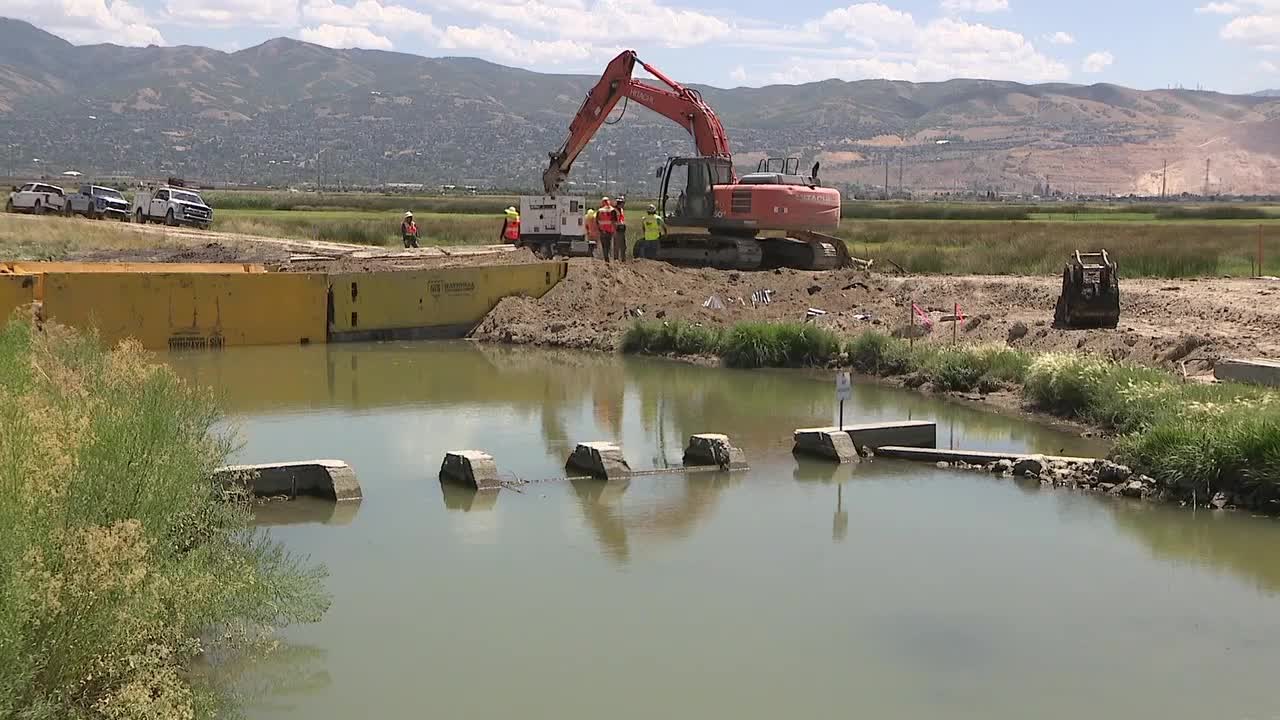WOODS CROSS, Utah — In an area on the edge of wetlands next to the Great Salt Lake, construction crews are working to replace a crucial piece of infrastructure.
A cement and wood dam built in the 1930s is finally being replaced.
"This one is particularly important because it is the primary inflow structure to all of Farmington Bay Waterfowl Management area," said Coryna Hebert, a regional biologist with the nonprofit group Ducks Unlimited, which is helping to fund and oversee the project. "This is about half of the inflow of the Jordan River to the Great Salt Lake."
When it's done? It will more efficiently get water into the wetlands and the lake itself.
"That’s one of the things we’re really excited about. With the new structure that’s going to be going in here, it’s going to be automated so we can control the gates with our cell phone," said David England, who managers the Farmington Bay Waterfowl Management Area. "Yeah, it’s a huge improvement."
A massive amount of money is being made available for more efforts like this to help reverse the Great Salt Lake's dramatic declines. This week, $53 million will be offered to fund ideas and projects to deliver water to the lake, build critical infrastructure and conservation projects centered around ecosystems and habitat. That money includes $50 million the Trump administration initially froze, before making it available for Utah to use.
"This is a very unique and amazing opportunity to provide a large amount of funding that will allow a range of applicants or ideas for projects that can protect wetlands, restore wetlands, bring water to Great Salt Lake, improve infrastructure," Marcelle Shoop with the Audubon Society, who oversees the Great Salt Lake Watershed Enhancement Trust, told FOX 13 News.
An 'amicable divorce' proposed in Colorado River negotiations:
The trust was created by the Utah State Legislature with the goal of getting water into the Great Salt Lake. It is run by the Audubon Society and The Nature Conservancy. The Great Salt Lake Commissioner's Office and Utah's Division of Forestry, Fire & State Lands and the trust are now soliciting applications and ideas on how to spend the millions. Groups or people interested in applying can find out more here.
The state intends to spend some of the money to acquire more water for the Great Salt Lake from agriculture producers, canal companies and other sources. They offer money to a farmer or canal company who, instead of growing an extra crop, sends the water to the lake.
"As we go into this hot, dry summer, if we can look at immediately getting water to the lake as well as setting up for future successes," said Hannah Freeze, the deputy Great Salt Lake Commissioner, whose office was directed by Utah's political leaders to craft a plan to reverse the lake's declines.
Money is also being earmarked for infrastructure projects like the one underway near Farmington Bay.
"Unfortunately, a lot of that infrastructure is really outdated and in some cases totally dysfunctional," Hebert told FOX 13 News. "So we ultimately need millions of dollars to replace all of it to ensure we have the proper hydrology to manage these wetland ecosystems."
It is a race against time as the Great Salt Lake continues to shrink. The lake has dropped significantly as a result of water diversions, drought and ongoing impacts from a changing climate. The lake's declines threaten public health and wildlife across northern Utah and beyond with reduced snowpack that cuts into drinking water supplies, toxic dust storms and billions in lost economic development. The lake is a refuge for millions of migratory birds and other wildlife.
Alarmed by the declines, people have protested and some environmental groups have sued, while Utah political leaders have dedicated more than $1 billion in funding and passed a series of bills centered around water conservation.
But some environmental groups and state officials working on the lake insist progress is being made, even if it isn't always visible.
"Last year we had over 68,000 acre feet of water that we worked on water transactions to deliver to the lake," Shoop said. "This year, we have well over 70,000. We have other transactions in the pipeline that haven’t been approved yet. We think we’re making great progress particularly to the trust’s goal of 100,000 acre feet by 2028."
While the lake continues to shrink, Freeze said salinity remains stable and avoids ecosystem collapse. The state manages a berm that divides the north and south arms of the lake.
"The salinity in the lake is in a really good place, so we’re not as concerned or we’re not in a panic, if you will, about the brine shrimp population and what that will do to our migrating birds," Freeze told FOX 13 News. "That’s a very real, very tangible thing the state has done to say we’re setting ourselves up for future success. Obviously we need to get more water to the lake and those things are happening. They’re happening slowly."
To maximize the $40 million it got from the legislature, the Great Salt Lake Watershed Enhancement Trust has also done some financial maneuvering to get more out of it. They created a special endowment that allows them to make money on what's in the account, stretch people's financial contributions further and reduce overhead expenses.
"It really does help leverage the state funding, provide more funding because you earn interest," Shoop said. "That allows you to use that interest to cover your costs or devote to projects, depending on how much you earn."
This article is published through the Great Salt Lake Collaborative, a solutions journalism initiative that partners news, education and media organizations to help inform people about the plight of the Great Salt Lake—and what can be done to make a difference before it is too late. Read all of our stories at greatsaltlakenews.org.




